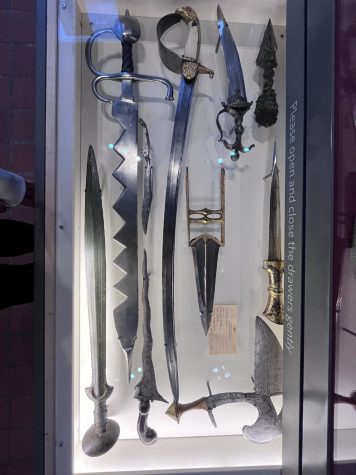
What dominated the displayed array of weapons was a Venetian boarding sword, used most commonly in naval battles. It was two feet in length and the handles’ curved edges melded into spiked iron wedges. The saw-toothed edge was useful for chopping the ropes of an enemy’s ship.
Alongside the boarding sword, another weapon whose uniqueness shone along its shiny silver facets was an ancient Rajasthani weapon called a katar. It had an elegant golden, H-shaped handgrip, with a triangular mount over it. A katar blade is held between the fingers, resulting in the blade going over the knuckles, making it an ideal weapon for quick-defense.
Despite their ancient origins, these weapons are polished to perfection and because of their subtle wear, they do not look like they have been used in battle. Each weapon features some sort of golden embellishment and intricate detail, as if made specifically to be showcased by a high-ranked, affluent leader. Historically, in large empires, there are different ranks of officials. The hierarchy of respect in an empire extends from everyday men who enlist to fight in battle to the privileged commanders of the higher ranks. High ranked officials’ golden weapons give them an unspoken power over those of lower standing which they command.

Simply by examining the composition of the weapon’s materials, viewers can understand the power structure of the Roman empire. Higher ranked officials kept opulent weapons which they did not use for self-defense, but instead kept as showpieces, which are spotless after centuries of their initial production. These higher ranked officials commanded lower ranked persons in war. The lower ranked soldiers were given small, cheaply made weapons to use to win battles for their empire. While the higher ranked commandants, who risked very little, are credited for the expansion of the Roman Empire, no one ever acknowledges or respects lower ranked officials who put their blood, sweat, and tears into winning a war they get no recognition for.
Standing in the John Higgins Armory Collection I studied both the pristine and tarnished weapons from the same time period, which were used in the same battles, but held by different ranks of people. Some weapons were held as ornamentation, while others were utilized for the purpose of self-defense. Our perception of famous generals, like Publius Quinctilius Varus, is that they fought bravely in contribution to the expansion of their empires, but in reality they did not contribute anything. We fail to recognize soldiers who actually fought, and who actually made the Roman Empire as powerful as it is known to be today. If it was not for lower ranked soldiers’ contribution to Roman expansion, the empire would not be adorned as highly in history as it is today.